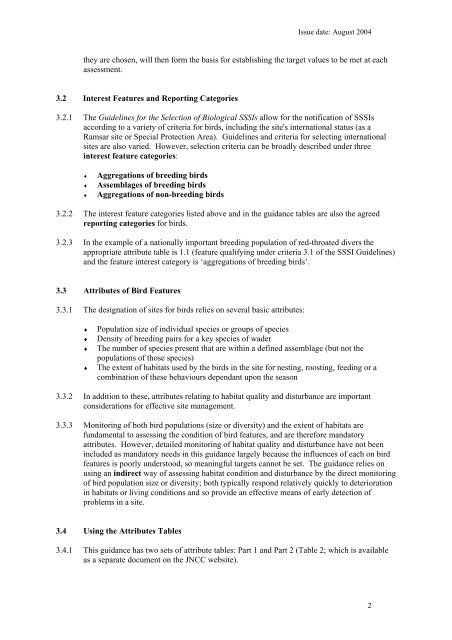Common Standards Monitoring guidance for birds - JNCC
Common Standards Monitoring guidance for birds - JNCC
Common Standards Monitoring guidance for birds - JNCC
You also want an ePaper? Increase the reach of your titles
YUMPU automatically turns print PDFs into web optimized ePapers that Google loves.
Issue date: August 2004<br />
they are chosen, will then <strong>for</strong>m the basis <strong>for</strong> establishing the target values to be met at each<br />
assessment.<br />
3.2 Interest Features and Reporting Categories<br />
3.2.1 The Guidelines <strong>for</strong> the Selection of Biological SSSIs allow <strong>for</strong> the notification of SSSIs<br />
according to a variety of criteria <strong>for</strong> <strong>birds</strong>, including the site's international status (as a<br />
Ramsar site or Special Protection Area). Guidelines and criteria <strong>for</strong> selecting international<br />
sites are also varied. However, selection criteria can be broadly described under three<br />
interest feature categories:<br />
♦<br />
♦<br />
♦<br />
Aggregations of breeding <strong>birds</strong><br />
Assemblages of breeding <strong>birds</strong><br />
Aggregations of non-breeding <strong>birds</strong><br />
3.2.2 The interest feature categories listed above and in the <strong>guidance</strong> tables are also the agreed<br />
reporting categories <strong>for</strong> <strong>birds</strong>.<br />
3.2.3 In the example of a nationally important breeding population of red-throated divers the<br />
appropriate attribute table is 1.1 (feature qualifying under criteria 3.1 of the SSSI Guidelines)<br />
and the feature interest category is ‘aggregations of breeding <strong>birds</strong>’.<br />
3.3 Attributes of Bird Features<br />
3.3.1 The designation of sites <strong>for</strong> <strong>birds</strong> relies on several basic attributes:<br />
♦<br />
♦<br />
♦<br />
♦<br />
Population size of individual species or groups of species<br />
Density of breeding pairs <strong>for</strong> a key species of wader<br />
The number of species present that are within a defined assemblage (but not the<br />
populations of those species)<br />
The extent of habitats used by the <strong>birds</strong> in the site <strong>for</strong> nesting, roosting, feeding or a<br />
combination of these behaviours dependant upon the season<br />
3.3.2 In addition to these, attributes relating to habitat quality and disturbance are important<br />
considerations <strong>for</strong> effective site management.<br />
3.3.3 <strong>Monitoring</strong> of both bird populations (size or diversity) and the extent of habitats are<br />
fundamental to assessing the condition of bird features, and are there<strong>for</strong>e mandatory<br />
attributes. However, detailed monitoring of habitat quality and disturbance have not been<br />
included as mandatory needs in this <strong>guidance</strong> largely because the influences of each on bird<br />
features is poorly understood, so meaningful targets cannot be set. The <strong>guidance</strong> relies on<br />
using an indirect way of assessing habitat condition and disturbance by the direct monitoring<br />
of bird population size or diversity; both typically respond relatively quickly to deterioration<br />
in habitats or living conditions and so provide an effective means of early detection of<br />
problems in a site.<br />
3.4 Using the Attributes Tables<br />
3.4.1 This <strong>guidance</strong> has two sets of attribute tables: Part 1 and Part 2 (Table 2; which is available<br />
as a separate document on the <strong>JNCC</strong> website).<br />
2
















